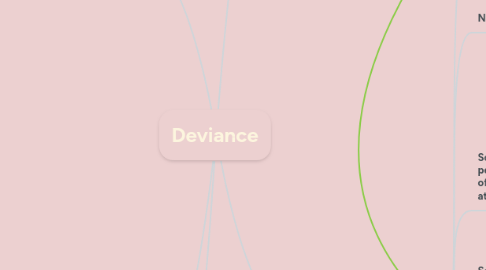
1. Definitions
1.1. Relativist: there are no universal or unchanging entities that define deviance for all times and in all places.
1.1.1. Deviance is whatever a social audience reacts against (or labels) as deviant. Something that elicits no reaction escapes identification as deviant.
1.2. Normative: Violation of a norm, a standard about “what human beings should or should not think, say, or do under given circumstances”
1.2.1. The label deviant depends on a group’s notion of actions and conditions that should and should not occur. This situational conception can change in different situations.
1.3. Statistical: behavior that differs from the average experience; it cites rare or infrequent phenomena. Assumes that what most people do determines the correct way to act.
1.3.1. Common conditions determine what is normal or non-deviant; anything in the statistical minority represents deviance.
1.4. Absolutist: assumes that everyone agrees on obvious, basic rules of a society, leading to general agreement that deviance results from the violation of previously defined standards for acceptable behavior.
1.4.1. Deviance results from a value judgment based on absolute standards. Certain actions and conditions qualify as deviant because they have always defined deviance
2. Social Norms
2.1. regulate human social relations and behavior; vary according to how widely people accept them, how society enforces them, how society transmits them, and how much conformity people require.
2.2. Norms
2.2.1. Proscriptive norms tell people what they should not do;
2.2.2. prescriptive norms tell them what they ought to do
2.2.3. Social Role: collection of norms that together convey expectations about appropriate conduct for persons in a particular position.
2.3. Social Differentiation: The instance that people differ from one another in a number of ways, including age, sex, race, educational attainment, and occupational status
2.3.1. Conditions that promote social differentiation also can promote deviance.
2.3.2. Stratification: describes the way in which different groups of people are placed within society. The status of people is often determined by how society is stratified - the basis of which can include; Wealth and income (Most common form of Stratification)
2.4. Social Cohesion: arises when bonds link members of a social group to one another and to the group as a whole.
2.5. Social Control: study of the mechanisms, in the form of patterns of pressure, through which society maintains social order and cohesion.
2.5.1. overt behavior by a human in the belief that the behavior increases or decreases the probability of some subsequent condition and the increase or decrease is desirable
2.5.2. Deliberately attempts to change behavior
2.5.3. External Pressures
2.5.3.1. influences conformity in the form of sanctions from others in the event of anticipated or actual nonconformity to norms.
2.5.3.1.1. Positive Sanction: reward meant to encourage conduct that conforms to a norm
2.5.3.1.2. Negative Sanction: punishment meant to discourage deviant conduct
2.5.4. Internalization of Social Norms
2.5.4.1. encourages conformity through socialization, so that people know what society expects and want to conform to that expectation
3. Theories
3.1. Biological
3.1.1. Phrenology: A specific region of the brain governs criminal behavior. Because this region is largest in criminals, skull dimensions provide good evidence of criminal tendencies.
3.1.2. Atavism: Criminals are evolutionary accidents who resemble primitive people more than modern people
3.1.3. Biological inferiority: Purports that those who commit deviance and crime are biologically inferior. Primary cause of crime; the government was tasked to sterilize or exile criminals.
3.1.4. Somatology: Body shapes affect personalities and thus criminality.
3.1.4.1. Endomorphs are heavy and relatively noncriminal
3.1.4.2. mesomorphs are muscular and prone to violence
3.1.4.3. ectomorphs are thin and introverted; non-criminal
3.2. Psychological
3.2.1. individual personality consists of the id, ego, and superego. Delinquency and crime result if the superego is too weak to control the id, or if the superego is so strong that individuals feel overly guilty and ashamed.
3.2.1.1. Moral Development: Children experience several stages of moral development. Incomplete moral development is a major reason for criminal and other antisocial behavior.
3.2.1.2. Intelligence: Low intelligence (IQ) produces criminality, in part because low IQ impairs moral reasoning and the ability to appreciate the consequences of one’s actions
3.2.1.2.1. Race: troubling racial overtones that echo the first uses of the IQ test a century ago. Several studies find African American–white differences in IQ scores, with the average scores of African Americans about ten to fifteen points below those for whites. Some researchers think this difference reflects the lower natural intelligence of African Americans and further think it explains why they commit more street crimes than whites do
3.2.1.3. Personality: Personality problems during childhood contribute to delinquency during adolescence and criminality during adulthood
4. Individual Adaptaions
4.1. Innovators: Those who accept culturally approved goals, but disregard the institutional means to achieve them
4.1.1. government employees and low-wage earners who commit grafts and corruption to achieve a higher standard of living
4.2. Ritualists: Those who give up cultural goals but follow the prescribed norms
4.2.1. a religious fanatic: an employee who reports to work but does nothing about improvement of the workplace
4.3. Retreatists: those who abandon cultural goals and also the prescribed means to achieve them
4.3.1. Drug addicts, hippies and alcoholics
4.4. those who reject both cultural goals and also the prescribed means to achieve them, but they try to establish new norms and goals
4.4.1. Organized Crime & Terrorism
